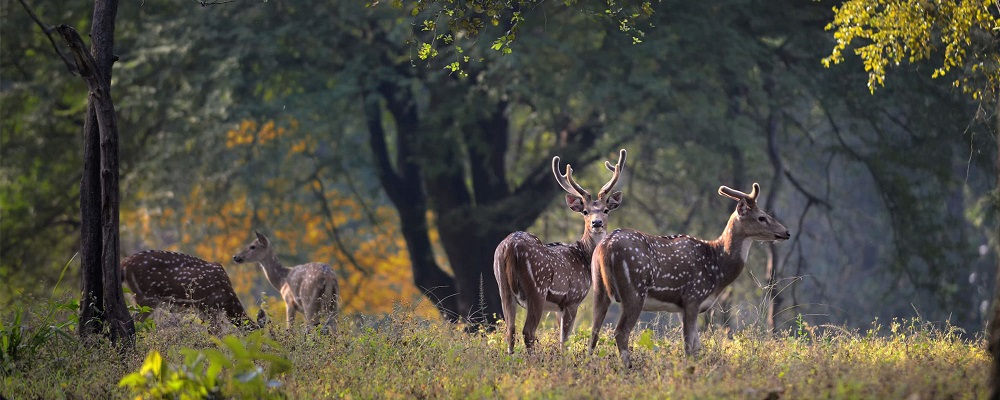The Satpura Range stands as a testament to the country's rich natural heritage. The Satpura National Park, along with the adjacent Bori and Pachmarhi wildlife sanctuaries, forms the Satpura Tiger Reserve, a haven for biodiversity and a crucial refuge for many endangered species. Spanning an area of 1,427 square kilometers, this reserve offers a unique blend of rugged landscapes, dense forests, and diverse wildlife, making it a must-visit destination for nature enthusiasts and conservationists alike.
A Diverse Ecosystem
Satpura Tiger Reserve boasts an extraordinary variety of flora and fauna. The park’s terrain, characterized by its sandstone peaks, narrow gorges, ravines, and dense forests, supports a rich ecosystem. The forests here range from dry deciduous to moist deciduous, with patches of tropical evergreen forests and bamboo groves.
This diverse habitat is home to a wide array of wildlife. The park is renowned for its significant population of leopards, sloth bears, and Indian bison (gaur). It is also one of the few places in India where one can spot the elusive Malabar giant squirrel and the Indian giant squirrel. The park’s rivers and lakes are inhabited by crocodiles and a variety of fish, adding to its ecological richness.
Birdwatchers find Satpura a paradise, with over 300 species of birds recorded in the area. The park is a habitat for both resident and migratory birds, including crested serpent eagles, Malabar pied hornbills, and paradise flycatchers. This avian diversity makes Satpura a critical site for bird conservation in central India.
Conservation Efforts
The Satpura Tiger Reserve is a critical part of India's efforts to conserve its natural heritage. The park is managed by the Madhya Pradesh Forest Department, which undertakes various initiatives to protect and preserve the wildlife and their habitats. Anti-poaching measures are stringent, with patrols and surveillance ensuring the safety of the park's inhabitants.
One of the significant successes of the reserve has been the increase in the population of tigers, leopards, and other large mammals, thanks to focused conservation efforts. Habitat management practices, such as controlled burning, water management, and grassland restoration, have been instrumental in maintaining the ecological balance of the reserve.
Community involvement plays a pivotal role in the conservation efforts at Satpura. Local communities are engaged in various eco-development activities, which help in reducing their dependency on forest resources. These initiatives include promoting sustainable agriculture, providing alternative livelihoods, and involving locals in eco-tourism activities.
Eco-Tourism and Sustainable Practices
Satpura National Park is a pioneer in promoting responsible and sustainable eco-tourism. The park offers a range of activities that allow visitors to experience its natural beauty while minimizing their ecological footprint. Jeep safaris, boat safaris, walking safaris, and canoeing are some of the ways tourists can explore the park.
Walking safaris, in particular, are a unique feature of Satpura, allowing visitors to connect intimately with nature. These guided walks, conducted by experienced naturalists, offer a chance to observe wildlife up close and understand the intricate details of the forest ecosystem.
The park management emphasizes eco-friendly practices, encouraging the use of local guides and promoting environmentally sustainable accommodations. Eco-lodges around the park are designed to blend with the natural surroundings and operate on principles of sustainability, using solar power, rainwater harvesting, and organic farming.
Challenges and Future Directions
Despite its successes, Satpura Tiger Reserve faces several challenges. Human-wildlife conflict, illegal grazing, and the pressure of tourism are ongoing concerns. Climate change also poses a threat, impacting the delicate balance of the ecosystem.
Addressing these challenges requires continuous effort and adaptation. Strengthening community participation, enhancing anti-poaching measures, and promoting climate-resilient practices are crucial. Additionally, raising awareness about the importance of conservation and sustainable tourism can help garner broader support for preserving this natural treasure.
Conclusion
Satpura Wildlife Heritage stands as a beacon of biodiversity and conservation in India. Its rich wildlife, diverse ecosystems, and commitment to sustainable practices make it a model for conservation efforts. By protecting Satpura, we not only preserve a unique natural heritage but also ensure that future generations can experience the wild beauty and ecological richness of this extraordinary landscape.




